Rechercher

Accueil du site > Equipes de Recherche > Population, développement et environnement dans la métropole d’Accra : une étude en deux phases > Méthodologie
Population, développement et environnement dans la métropole d’Accra : une étude en deux phases
Méthodologie
The first phase of the project involved the collation of existing census, survey and health data for the city and organizing these data in a common geographical database.
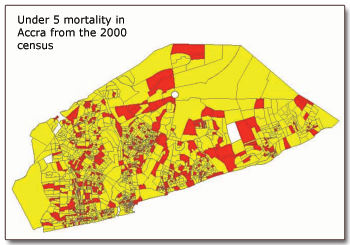 The primary unit of analysis was the 2000 census Enumeration Areas (EAs) of which there are 1741 in the city. The census data allow the calculation of a measure of early childhood mortality as well as providing detailed information about living conditions at the household level. The routine death registration data for 1999, 2000 and 2001 were captured in a new database with the usual addresses, age, sex and cause of death of the deceased. Environmental conditions in each EA were then assessed from ground enquiries and from a digitised satellite image available for 2002. The Digital Globe multi-spectral satellite image of Accra was purchased and used to classify areas into land cover classes using the so-called “multiple end member spectral mixture” analysis with creation of variables representing land use and landscape metrics as measure of the built and natural environment.
The primary unit of analysis was the 2000 census Enumeration Areas (EAs) of which there are 1741 in the city. The census data allow the calculation of a measure of early childhood mortality as well as providing detailed information about living conditions at the household level. The routine death registration data for 1999, 2000 and 2001 were captured in a new database with the usual addresses, age, sex and cause of death of the deceased. Environmental conditions in each EA were then assessed from ground enquiries and from a digitised satellite image available for 2002. The Digital Globe multi-spectral satellite image of Accra was purchased and used to classify areas into land cover classes using the so-called “multiple end member spectral mixture” analysis with creation of variables representing land use and landscape metrics as measure of the built and natural environment.
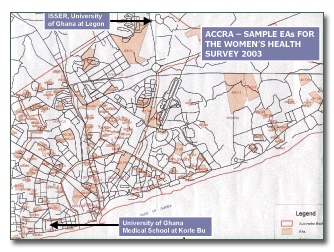 Health data on women were added from the Accra Women’s Health Survey (WHSA - fieldwork March –July 2003) with the geocodes for the sample EAs. Objectively assessed and subjectively reported measures of adult health were available for a representative sample of 3200 women aged 18 and over from the AWHS.
Health data on women were added from the Accra Women’s Health Survey (WHSA - fieldwork March –July 2003) with the geocodes for the sample EAs. Objectively assessed and subjectively reported measures of adult health were available for a representative sample of 3200 women aged 18 and over from the AWHS.
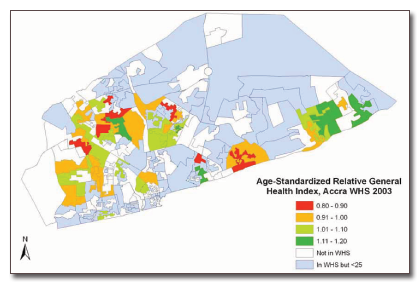 These data were linked and a spatial statistical analysis conducted to assess measures of association between environment, living standards and health. The basic model tested with data on health derived from census and/or vital statistics was as follows : Health levels in EA fn (individual socio-demographic characteristics, characteristics of neighbourhood environment, including census variables, satellite image variables, and proximity and use of health facilities).
These data were linked and a spatial statistical analysis conducted to assess measures of association between environment, living standards and health. The basic model tested with data on health derived from census and/or vital statistics was as follows : Health levels in EA fn (individual socio-demographic characteristics, characteristics of neighbourhood environment, including census variables, satellite image variables, and proximity and use of health facilities).
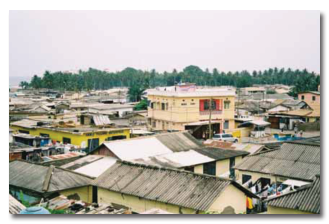 In the second phase, new fieldwork based on focus group interviews and re-interview of some of the Women’s Health Survey women resident in Nima and Maamobi produced some new data on the community’s own perceptions of environmental hazards. The purpose of these interviews was to compare the objectively assessed and subjectively reported risks and to match the two to be able to draw appropriate conclusions and lessons. This framework was empirically tested in Nima and Maamobi, which are very poor urban neighbourhoods in Accra. As a prelude to the empirical assessment of the environmental risks, the study surveyed the background characteristics of the population in the poor urban neighbourhoods.
In the second phase, new fieldwork based on focus group interviews and re-interview of some of the Women’s Health Survey women resident in Nima and Maamobi produced some new data on the community’s own perceptions of environmental hazards. The purpose of these interviews was to compare the objectively assessed and subjectively reported risks and to match the two to be able to draw appropriate conclusions and lessons. This framework was empirically tested in Nima and Maamobi, which are very poor urban neighbourhoods in Accra. As a prelude to the empirical assessment of the environmental risks, the study surveyed the background characteristics of the population in the poor urban neighbourhoods.
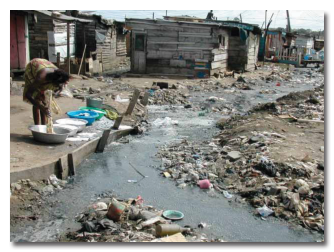
Dans la même rubrique :